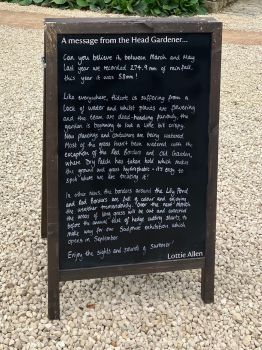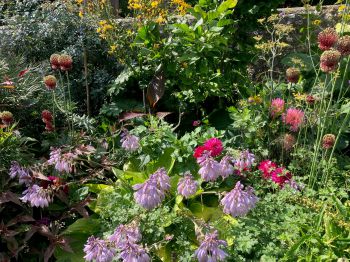News
Gardens & Gardeners of Sussex: Ownership, Community, Legacy
Posted on behalf of: Centre for Life History and Life Writing Research
Last updated: Wednesday, 8 October 2025

Visitor message from Lottie Allen, Head Gardener at Hidcote Manor copyright Peter Robinson

The Old Vicarage, Washington, 2025, credit Peter Robinson
As my time at Sussex draws to a close, it’s incumbent upon me to briefly reflect upon the many positive aspects of my visit. Reacquainting myself with the University, its distinctive architecture and rich atmosphere of intellectual inquiry, after a 15-year absence, I have been pleased to see that it continues to champion research that has a direct global impact, while also highlighting locally important projects, such as the work being undertaken at the CLHLWR. Shortly after my arrival, I was delighted to attend a conference organized by Prof. Vinita Damoradan on environmental history, which opened my eyes to another aspect of managed landscapes and reaffirmed the importance of activism. Much of my time has been, inevitably, spent off campus, visiting the many gardens that make Sussex a county of unparalleled horticultural excellence. Visits to more than 20 gardens, including those considered ‘horticultural royalty’, have been interspersed with forays to other gardens that have long been on my radar, but which have—for various reasons—eluded me, such as the privately owned Pashley Manor in East Sussex. My focus has been on understanding the garden as a working and lived-in space, so I have been less amongst the petunias and pelargoniums, and more around the potting sheds, bothies, and long-forgotten outbuildings, snatching, wherever possible, a few words with busy garden staff. It must be said that in a little over five months, I’ve had full value from my National Trust membership!
One aspect of my research that has been particularly rewarding is that I’ve been able to see a number of gardens directly associated with artistic creativity. Charleston Farmhouse, home to artists Vanessa Bell and Duncan Grant, and Monks House, the charming Woolf residence, are two examples. Homes associated with literary and artistic individuals seem to me to be especially confessional and intimate in their nature, and through analysis of their owner’s work we can see how they interacted with their gardens as owner-creators in a way seldom possible with larger, more celebrated estates. Further afield, and by way of comparison, I’ve been fortunate to visit gardens in the Lake District, including Wordsworth’s Dove Cottage and John Ruskin’s Brantwood (a particular highlight), as well as Abbotsford in the Scottish Borders, the suitably fanciful home of Sir Walter Scott. On a lengthy road trip around Britain, I dodged recoiled adders to reach George Orwell’s hideaway on the remote island of Jura, and switching coasts, embraced fierce North-sea gales at Lindisfarne Castle, the Lutyens-inspired home of Edward Hudson, founder of Country Life magazine which did so much to promote Sussex country houses and gardens in the Edwardian golden age. In a slightly indulgent ‘final fling’, I’ve recently returned from a delightful visit to Tuinen Mien Ruys (1904-1999) in Dedemsvaart, The Netherlands, created by a garden designer strongly influenced by Gertrude Jekyll and doyen of Dutch garden design.
Despite these longer journeys, my attention has always remained firmly on Sussex, and this has included getting a better understanding of how the varied geology and topography of the county provided the backbone for the creation of a series of world-renowned gardens in the early twentieth century. Through a mixture of field visits, wide-ranging reading, and archival research, it has become evident to me that, notwithstanding the recent (and much-needed) rise in the profile of head gardeners through books such as Toby Musgrave’s The Head Gardeners (2007) and Ambra Edwards’ Head Gardeners (2017)—the latter containing interviews with at least three Sussex-based head gardeners—a large swathe of the gardens and gardeners of Sussex have been almost completely ignored. I refer here to the thousands of private gardens and their gardeners who cultivate the soil with varying degrees of success, seeking no exposure or attention, but who nevertheless find the activity meaningful in some way. By viewing gardens as integral to people’s complex, busy, and often chaotic lives, and resisting the urge to place them on pedestals of horticultural excellence; by seeing gardens—whatever their size, scope or design—not as ends in themselves, but in the round, jostling for attention with the day job, childcare, redecoration, and the family pooch, their important role in shaping lives can be amplified.
The challenge with this approach has always been to find a way of peeping over the hedgerows of these sacred spaces, and to understand the function of an ordinary garden with necessarily limited ambition. In order to do so, I’ve turned to the Mass Observation Library. In responses to Directives, diaries, and other related material produced by a wide range of participants, I’ve begun to see people’s unvarnished interactions with their gardens; from what they wore in the garden, to moving accounts of men-folk toiling away in their gardens and allotments prior to active service in WWII, with the hope that their effort might sustain their loved ones back home, to rancouring over historical scrumping rights. What has emerged so far, is the profound contrast, often in adjoining sentences, between awareness of large events—meta narratives if you will—interposed with mundane comments about specific garden activities such as hoeing up potatoes. This oscillation between the consciousness of larger events (which people often feel powerless to stop or even to fully comprehend) and individual experience in the garden space was alluded to by Vita Sackville-West in her opening line of The Garden (1946): ‘Small pleasures must correct great tragedies/Therefore of Gardens in the midst of war, I boldly tell. (l. 1-2, p. 13), and it is something that is relevant to accounts of the use and importance of gardens during the recent COVID-19 pandemic too.
Another way of accessing these unstudied Sussex gardens and their gardeners, is through the National Garden Scheme (NGS), in which private individuals open their own gardens to the public for a short period (often just one or two days) for charity. Having had the opportunity to visit three such gardens: Wiston House, Sullington Old Rectory, and The Old Vicarage (Washington), I’ve been struck by the superior quality of their horticulture and the general condition of the borders. They seemed less sterile than gardens permanently open to the public—less fatigued—their energy provided by a lived-in feel, an observation that raises questions about the way the National Trust and other similar bodies handle their many gardens when the impetuous of the owner has gone, and they transition away from being just a part of someone’s existence to the whole. Small or large, what comes across with NGS gardens is the presence of pride in the ‘well’ sense used by Austen. In the remaining time I have at Sussex, I am exploring this interesting aspect using the NGS ‘Yellow books’ and other papers to which I have kindly been granted access by the organization’s CEO, George Plumptre.
Horticulturally, it has been a tough year for professional and home (I reject the pejorative ‘amateur’) gardeners alike. Following months of drought, as I write, sixty mph winds are lashing the great oaks visible from my ‘hut with a view’ on the fringes of the Sussex Weald. It is a mast year, and there will be significant losses. But every gardener knows that in the garden, as in research, there are more swings and roundabouts than a theme park, and I’m reminded of the lines of that great satirist of the garden Karel Čapek when writing about the vagaries of the English weather, ‘it always shoots over the mark on one side or other’, for when it is ‘not too dry, it is inevitably too wet’ (Čapek, The Gardener’s Year, 1929). Fortunately, as I prepare for my departure, all is set fair.
Peter Robinson is Associate Professor in the Department of English at Japan Women’s University. He is a Visiting Research Fellow at the at Centre for Life History and Life Writing Research, University of Sussex, 2025
Further information: https://www.sussex.ac.uk/research/centres/centre-for-life-history-and-life-writing-research/research/projects/sussex-retold